
A bogie is a chassis or framework that carries a wheelset, attached to a vehicle—a modular subassembly of wheels and axles. Bogies take various forms in various modes of transport. A bogie may remain normally attached or be quickly detachable ; it may contain a suspension within it, or be solid and in turn be suspended ; it may be mounted on a swivel, as traditionally on a railway carriage or locomotive, additionally jointed and sprung, or held in place by other means.

A shock absorber or damper is a mechanical or hydraulic device designed to absorb and damp shock impulses. It does this by converting the kinetic energy of the shock into another form of energy which is then dissipated. Most shock absorbers are a form of dashpot.

The French 75 mm field gun was a quick-firing field artillery piece adopted in March 1898. Its official French designation was: Matériel de 75mm Mle 1897. It was commonly known as the French 75, simply the 75 and Soixante-Quinze. The French 75 was designed as an anti-personnel weapon system for delivering large volumes of time-fused shrapnel shells on enemy troops advancing in the open. After 1915 and the onset of trench warfare, other types of battlefield use demanding impact-detonated high-explosive shells prevailed. By 1918 the 75s became the main agents of delivery for toxic gas shells. The 75s also became widely used as truck mounted anti-aircraft artillery. They were the main armament of the Saint-Chamond tank in 1918.

Suspension is the system of tires, tire air, springs, shock absorbers and linkages that connects a vehicle to its wheels and allows relative motion between the two. Suspension systems must support both road holding/handling and ride quality, which are at odds with each other. The tuning of suspensions involves finding the right compromise. It is important for the suspension to keep the road wheel in contact with the road surface as much as possible, because all the road or ground forces acting on the vehicle do so through the contact patches of the tires. The suspension also protects the vehicle itself and any cargo or luggage from damage and wear. The design of front and rear suspension of a car may be different.

Hydropneumatic suspension is a type of motor vehicle suspension system, designed by Paul Magès, invented by Citroën, and fitted to Citroën cars, as well as being used under licence by other car manufacturers, notably Rolls-Royce, Maserati and Peugeot. It was also used on Berliet trucks and has more recently been used on Mercedes-Benz cars, where it is known as Active Body Control. The Toyota Soarer UZZ32 "Limited" was fitted with a fully integrated four-wheel steering and a complex, computer-controlled hydraulic Toyota Active Control Suspension in 1991. Similar systems are also widely used on modern tanks and other large military vehicles. The suspension was referred to as oléopneumatique in early literature, pointing to oil and air as its main components.
A hydraulic accumulator is a pressure storage reservoir in which an incompressible hydraulic fluid is held under pressure that is applied by an external source of mechanical energy. The external source can be an engine, a spring, a raised weight, or a compressed gas. An accumulator enables a hydraulic system to cope with extremes of demand using a less powerful pump, to respond more quickly to a temporary demand, and to smooth out pulsations. It is a type of energy storage device.
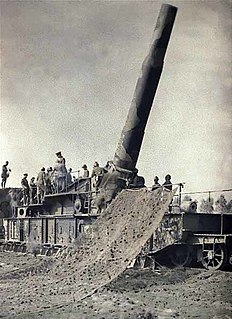
A railway gun, also called a railroad gun, is a large artillery piece, often surplus naval artillery, mounted on, transported by, and fired from a specially designed railway wagon. Many countries have built railway guns, but the best-known are the large Krupp-built pieces used by Germany in World War I and World War II. Smaller guns were often part of an armoured train. Only able to be moved where there were good tracks, which could be destroyed by artillery bombardment or airstrike, railway guns were phased out after World War II.
A dashpot, also known as a damper, is a mechanical device that resists motion via viscous friction. The resulting force is proportional to the velocity, but acts in the opposite direction, slowing the motion and absorbing energy. It is commonly used in conjunction with a spring. The process and instrumentation diagram (P&ID) symbol for a dashpot is .
A gun carriage is a frame and mount that supports the gun barrel of an artillery piece, allowing it to be maneuvered and fired. These platforms often had wheels so that the artillery pieces could be moved more easily. Gun Carriages where also used on ships to facilitate the movement and aiming of large cannons.
A recoil buffer is a factory-installed or aftermarket component of firearms which serves to reduce the velocity and/or cushion the impact of recoiling parts of a firearm.
An active suspension is a type of automotive suspension on a vehicle. It uses an onboard system to control the vertical movement of the vehicle's wheels relative to the chassis or vehicle body rather than the passive suspension provided by large springs where the movement is determined entirely by the road surface. Active suspensions are divided into two classes: real active suspensions, and adaptive or semi-active suspensions. While semi-adaptive suspensions only vary shock absorber firmness to match changing road or dynamic conditions, active suspensions use some type of actuator to raise and lower the chassis independently at each wheel.
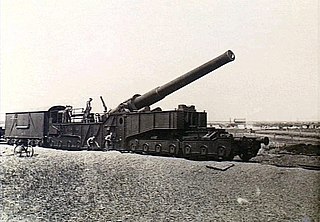
The British Ordnance BL 12 inch gun Mk IX on truck, railway mounted surplus 12 inch Mk IX W naval guns, manufactured by Woolwich Arsenal in 1906, on various railway platforms to provide mobile long-range heavy artillery for the British Army on the Western Front in World War I.
A regenerative shock absorber is a type of shock absorber that converts parasitic intermittent linear motion and vibration into useful energy, such as electricity. Conventional shock absorbers simply dissipate this energy as heat.
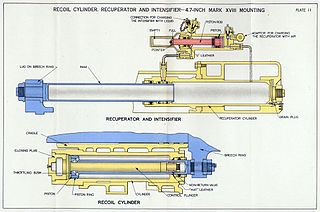
A hydraulic recoil mechanism is a way of limiting the effects of recoil and adding to the accuracy and firepower of an artillery piece.

Integral Coach Factory (ICF) coaches are conventional passenger coaches used on the majority of main-line trains in India. The design of the coach was developed by Integral Coach Factory, Perambur, Chennai, India in collaboration with the Swiss Car & Elevator Manufacturing Co, Schlieren, Switzerland in the 1950s. The design is also called the Schlieren design based on the location of the Swiss company. The 1st ICF coach had been flagged by then Prime Minister Jawaharlal Nehru on 2 October 1955. The last ICF coach was flagged off by senior technician Shri Bhaskar P. in the presence of Railway Board Chairman Ashwani Lohani on 19 January 2018. The Indian Railways intends to phase out ICF coaches and replace all of them with the newer LHB coaches and Train 18 or Train 20 coaches over a period of time, once the codal life of the existing ICF coaches end.
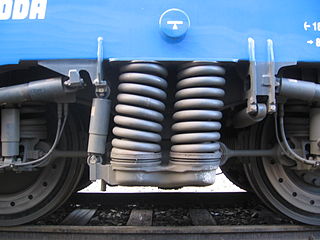
Flexicoil suspension is a type of secondary suspension for railway vehicles, typically having steel coil springs between the bogie trucks and chassis/frame of a passenger coach, goods freight wagon, or locomotive. Suspension systems using steel springs are more common than those with air springs, as steel springs are less costly to make, relatively wear resistant, and require less maintenance.

An oleo strut is a pneumatic air–oil hydraulic shock absorber used on the landing gear of most large aircraft and many smaller ones. This design cushions the impacts of landing and damps out vertical oscillations.
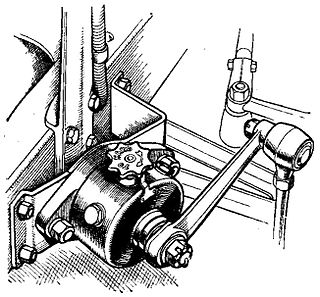
Lever arm shock absorbers were the first form of hydraulic shock absorber or damper used for car suspension. They appeared in the 1930s and were most commonly used in the 1950s and 1960s, but were replaced by telescopic shock absorbers in the 1970s. One of the earliest patents for a hydraulic lever arm shock absorber was awarded in 1925 to Georges de Ram, who was already an established maker of friction disk shock absorbers.

The Canon de 24 C modèle 1876 was a coastal defense gun designed and built before World War I. A number of guns were also converted to railway guns during World War I in order to meet a need for heavy artillery.

The Canon de 19 C modèle 1875 was a coastal defense gun designed and built in the 1870s. A number of guns were also converted to railway guns during World War I in order to meet a need for heavy artillery.

















